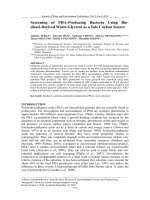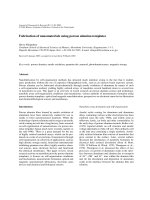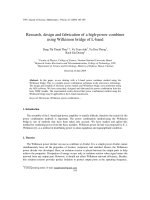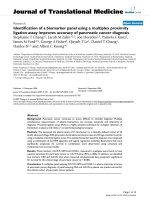- Trang chủ >>
- Khoa Học Tự Nhiên >>
- Vật lý
Fabrication of a porous polyimide membrane using a silicon nanowire array as a template
Bạn đang xem bản rút gọn của tài liệu. Xem và tải ngay bản đầy đủ của tài liệu tại đây (357.63 KB, 4 trang )
Fabrication of a porous polyimide membrane using a silicon nanowire array
as a template
Woong Kim
⁎
, Myung-Ki Lee
Department of Materials Science and Engineering, Korea University, Seoul 136-713, South Korea
abstractarticle info
Article history:
Received 10 October 2008
Accepted 17 January 2009
Available online 26 January 2009
Keywords:
Nanomaterials
Polymers
Porosity
Membranes
Nanowires
Polyimide
We demonstrate that a porous polyimide membrane can be fabricated by curing liquid polyimide on a
vertically oriented silicon nanowire array and selectively etching away the nanowire-array-template using
xenon difluoride (XeF
2
). Pore size and density using the described technique are controllable. The former is
dependent on nanowire diameter and the duration of etching, whereas pore density is determined by silicon
nanowire density. We believe that the described porous membrane fabrication method can be applied to
various polymer and nanowire systems.
© 2009 Elsevier B.V. All rights reserved.
1. Introduction
Porous polymer membranes have many applications in biotech-
nology and electronics for the separation and/or filtration of gases,
biomolecules, and environmentally hazardous materials, and as in-
sulating materials with low dielectric constants [1–4]. It has also been
recently demonstrated that porous polymer membranes can be used
as templates to synthesize silicon nanowires electrochemically [5].
Among the many polymers available, polyimide (PI) has been widely
used in academia and industrially due to its high thermal stability,
good chemical resistance, and excellent mechanical properties [6].
Porous polyimide membranes have been prepared via the phase
inversion of cast films [7], by irradiation with energetic heavy ions and
subsequent oxidization [8], and by the decomposition of thermally
labile domains in phase-separated block copolymers [4]. In this letter,
we describe the preparation of a porous polyimide membrane using a
vertically oriented silicon nanowire (SiNW) array as a template. Since
the diameters and densities of silicon nanowires can be controlled,
polyimide membranes with predetermined pore densities and
diameters can be readily produced using the described technique.
2. Experimental procedures
Silicon nanowires were synthesized on silicon (111) substrates by
chemical vapor deposition (CVD) as described elsewhere [9]. Briefly,
gold (Au) nanoparticles were deposited on silicon substrates as
catalytic seeds. SiCl
4
(the silicon source) was then introduced into a
CVD reactor containing a silicon substrate at 850 °C using H
2
(10%) in
Ar as a carrier gas. Silicon nanowires grew vertically from substrates.
Polyimide solution (PI-2556) was purchased from HD Microsystems.
A drop of this solution was applied onto silicon substrates with
nanowires. The solution was cur ed at 200 °C for 30 min in a nitrogen
stream, which resulted in a solid polyimide membrane over the
embedded nanowires. The membra ne was then slightly etched with O
2
plasma (20 min at 1 00 W in a 50 sccm O
2
stream) to expose the silicon
nanowire tips. A u nanoparticles at the tips of the nanowires were then
etched using potassium iodide and iodine (KI/I
2
) solution, and the
substrate was thoroughly rinsed with deionized (DI) water. To selectively
etch the silicon nanowires and lea ve the polyimide membr ane intact,
XeF
2
etching was c arried out over 5 0–200 cy cles of exposure t o 4 Torr of
XeF
2
and 2 Torr of N
2
for 60 s . Polyimide membr anes were e ither
detached from silicon substr at es aft er this stage o r were detached by
dipping substr at es in buffered hydrofluoric acid (BHF) so lution. F or
scanning ele ctron microscopy (S EM) characterizations, a bout 5 nm of Au
was sputter ed onto the poly imide membranes produced.
3. Results and discussion
The procedure used to fabricate the porous polyimide membranes
is summarized in Fig. 1.Asafirst step, silicon nanowires were
epitaxially grown on Si (111) substrates by CVD. Since nanowires grow
preferentially in theb111Ndirection under the conditions used, they
were oriented vertically to the substrate. An SEM image of an angled
view of the vertically aligned silicon nanowires is shown in Fig. 1a.
Since nanowires grow via a vapor liquid solid (VLS) mechanism, gold
nanoparticles (AuNPs) are retained at the tips of the nanowires; these
appeared as bright dots in SEM images (Fig. 1a).
Materials Letters 63 (2009) 933–936
⁎ Corresponding author. Tel.: +82 2 3290 3266; fax: +82 2 928 3584.
E-mail address: (W. Kim).
0167-577X/$ – see front matter © 2009 Elsevier B.V. All rights reserved.
doi:10.1016/j.matlet.2009.01.060
Contents lists available at ScienceDirect
Materials Letters
journal homepage: www.elsevier.com/locate/matlet
Fig. 1. Fabrication process used to produce porous polyimide membranes using silicon nanowire arrays as templates; (a) synthesis of silicon nanowires, (b) polyimide coating,
(c) polyimide etching with O
2
plasma, and (d) silicon etching with XeF
2
. A schematic of a cross sectional view is shown under each SEM image.
Fig. 2. SEM images of porous polyimide membranes with pore density of (a, b) ~1 pore/100 μm
2
, and (c, d) ~10 pores/100 μm
2
.
934 W. Kim, M K. Lee / Materials Letters 63 (2009) 933–936
The nanowire array substrates were covered with polyimide
solution, which was dropped onto substrates. Final membrane
thickness can be adjusted by simply altering the amount of solution
applied. About 5–10 μl of polyimide solution was found to
be appropriate for a silicon substrate of 0.5 by 0.5 cm. Substrates
treated with polymer solution were cured at 200 °C. This process
results in the formation of polyimide membranes on nanowires.
The film becomes extremely thin at the nanowire tips as shown in
Fig. 2b.
To expose nanowires, the polyimide membrane was etched with
O
2
plasma. Etching conditions, e.g., power, duration, and O
2
flow rate,
were optimized to expose only the upper portions of nanowires
without appreciably damaging the supporting polyimide. An SEM
image of the exposed portion is shown in Fig. 1c. Having exposed the
nanowires, the Au nanoparticles at the nanowire tips were removed
using gold etchant (KI/I
2
) solution [10].
Finally, the silicon component of nanowires was selectively
removed using XeF
2
as etchant. Etch rate of polyimide is negligible
Fig. 3. Silicon nanowires with various diameters; (a) ~50, (b) 90, (c) 150, and (d) 220 nm. Nanowires were synthesized from gold nanoparticles with diameter of ~ 30, 50, 100, and
150 nm, respectively.
Fig. 4. SEM images of porous membranes with various pore sizes; (a) ~800 nm, (b) 1 μm, and (c) 1.5 μm. Pore sizes are dependent nanowire diameter, which in the present study were
90, 150, and 400 nm, respectively. Pore size is dependent on etching time, e.g., (a) ~800 nm at 200 cycles vs. (d) ~170 nm at 50 cycles.
935W. Kim, M K. Lee / Materials Letters 63 (2009) 933–936
compared to that of silicon [10]. Fig. 4b shows the top surface of a pore-
containing polyimide membrane after this selective etching process.
As mentioned earlier, membrane pore density is wholly dependent on
nanowire density, which is in turn determined by gold nanoparticle
density . Moreover , there is usually a near one to one r elation between
nanowire and gold nanoparticle numbers [11]. Fig. 2 shows two
membranes with different pore densities. A membrane with a pore
density o f ~1/100 μm
2
is shown in SEM images with d ifferent
magnifications (Fig. 2aandb),andamembranewithdensityof~10
pores/100 μm
2
is shown in Fig. 2candd.
The por e s ize c a n a lso be contr olled, as it is dependent on two fact ors
only; namely , template-nanowire diameter and the duration of XeF
2
etching. On t he other hand, wire diameter is determined by gold
nanoparticle size and i s s lightly larger than t he AuNP seeds. Fi g. 3 shows
nanowires with various diameters of ~50, 90, 1 50 and 220 nm syn-
thesized from Au nanoparticles with diameter of ~30, 50 100 and
150 nm, respectively. Fig. 4 a, b, and c show polyimide membranes
fab ricated using silicon nan owires with diameter of ~90, 150, and
400 nm, respectively. After exp osure to XeF
2
for 200 cycles, the
resulting pore diameter were ~800 nm, 1 μmand1.5μm, respectively.
Etching time also affected pore siz e. For exam ple, 90 nm silicon
nan owires resulted in pore diameters of ~170 nm when membranes
were exposed to XeF
2
for 50 cycles (Fig. 4d), while the final pore
diameter was ~800 nm when 200 cycles were used (Fig. 4a).
Interestingly, when etching time was reduced, the original hexagonal
cross sections of the nanowires were transferred to the pores (Fig.
4d). Further optimization of the descri bed process is expected to
inc rease the ranges of the pore diameters and densitie s formed.
4. Conclusions
Our studies indicate that silicon nanowires can be used as
sacrificial templates for the fabrication of porous polyimide mem-
branes. Moreover, since the densities and diameters of silicon nano-
wires can be easily adjusted, membranes can be fabricated with pre-
determined pore densities and sizes. In the present study, membranes
were successfully fabricated with pore diameters ranging from
170 nm to 1.5 μm and densities ranging from 0.1 to 1 pore/10 μm
2
.
Furthermore, the novel fabrication technique described can be applied
to the fabrication of porous membranes from different polymers and
template nanowires comprising different materials.
Acknowledgement
This work was supported in part by the Korea Science and
Engineering Foundation through the Pioneer Converging Technology
Program (No. M10711160001-08M1116-00110).
References
[1] Pandey P, Chauhan RS. Prog Polym Sci 2001;26:853–93.
[2] Ulbricht M, Yang H. Chem Mater 2005;17:2622–31.
[3] Mendelsohn JD, Barrett CJ, Chan VV, Pal AJ, Mayes AM, Rubner MF. Langmuir
2000;16:5017–23.
[4] Hedrick JL, Miller RD, Hawker CJ, Carter KR, Volksen W, Yoon DY, et al. Adv Mater
1998;10:1049–53.
[5] J. Mallet, M. Molinari, F. Martineau, F. Delavoie, P. Fricoteaux, M. Troyon, Nano Lett
2008;8:3468–74.
[6] Wilson AM. Thin Solid Films 1981;83:145–63.
[7] Echigo Y, Iwaya Y, Saito M, Tomioka I. Macromolecules 1995;28:6684–6.
[8] Trautmann C, Bruchle W, Spohr R, Vetter J, Angert N. Nucl Instrum Meth Phys Res
Sect B-Beam Interact Mater Atoms 1996;111:70–4.
[9] Hochbaum AI, Fan R, He RR, Yang PD. Nano Lett 2005;5:457–60.
[10] Williams KR, Gupta K, Wasilik M. J Microelectromech Syst 2003;12:761–78.
[11] Wang DW, Tu R, Zhang L, Dai HJ. Angew Chem Int Ed 2005;44:2925–9.
936 W. Kim, M K. Lee / Materials Letters 63 (2009) 933–936









